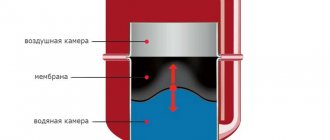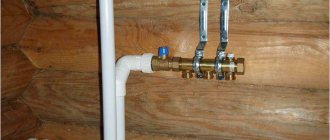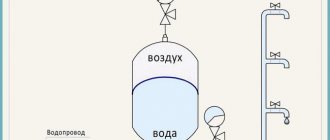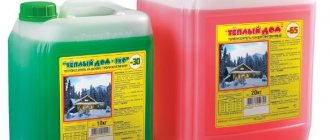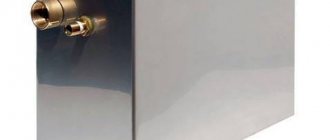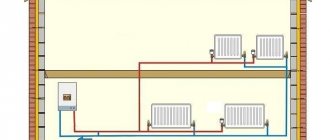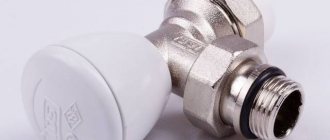Types of expansion tanks
In heating systems, mainly three types of expansion tanks are used: open, closed and membrane
.
1. Open type expansion tanks
designed for use in a heating system with natural coolant circulation. This is an ordinary open container, in the bottom of which there is a special connector with the heating system. The container is located at the highest point of the heating system. Due to the fact that the tank is located somewhere in the attic, on the staircase, in the roof, a major inconvenience arises: to determine the level of liquid in the tank, you periodically have to go up to the attic and carry out visual inspection. Also, open tanks must be covered with thermal insulation. They are made mainly from sheet steel, the shape of the tanks is rectangular or cylindrical. The tank is equipped with an inspection hatch on top. The maximum liquid level in such tanks is controlled by an overflow tube facing the street.
Open expansion tanks are designed not only to maintain the volume of coolant in the system during temperature fluctuations, but also to replenish the volume of water in the system in the event of a leak. Limiting hydraulic pressure in the heating system, discharging excess water into the sewer when overflowing, controlling the operation of make-up devices, removing air from the system - these functions are also performed by an open-type expansion tank.
The disadvantage is bulkiness and the associated wasteful heat loss. Air absorption due to excessive cooling of water leads to increased internal corrosion of heating devices and pipes. Finally, in many cases it is necessary to lay special connecting pipes. Due to a large number of disadvantages, open-type expansion tanks are rarely used in modern heating systems.
2. Closed expansion tanks
used both in open heating systems with natural circulation of liquid, and in closed systems with forced circulation. The advent of closed tanks made it possible to operate heating systems without contact with the atmosphere. The coolant circulates without any admixtures of aggressive gases that cause corrosion. The service life of heating equipment and pipes is significantly increased. Also, the heating system can operate at higher pressure, without the need for replenishment, since there is no water leakage. Closed expansion tanks are usually located in the boiler room, therefore do not require frost protection, and operate reliably throughout the season. These tanks are sealed devices equipped with automatic or manual air release valves. If the tank is equipped with a manual valve, then the filling of the heating system, as is the case with an open tank, is controlled visually. If the air is released automatically, then the filling of the system is controlled by a pressure gauge that measures the fluid pressure in the system.
3. Membrane type expansion tanks
— modern equipment operating fully automatically. The main detail that distinguishes this tank from a regular closed-type tank is the elastic membrane. The membrane divides the tank into two parts: the water part contains compressed air, and the other contains the coolant. Compressed air membranes make it possible to reduce the size of the expansion tank by four times. A tank with a capacity of several liters fits successfully into the body of a double-circuit boiler.
Since the tank is absolutely sealed and the membrane is movable, the same pressure is applied to the membrane on both sides. The principle of operation of the tank is quite simple: when heated, the coolant pressure increases; excess water enters one compartment of the expansion tank, increasing its pressure on the membrane; an elastic membrane prevents water from entering the second compartment, but the air pressure in this compartment increases and compensates for the increased liquid pressure. As the liquid cools, its pressure decreases and compressed air pushes it back into the system, keeping the system pressure constant. If the air pressure in the tank for some reason becomes critical, the pump will automatically turn off. Restarting the system will only be possible when the air pressure reaches a minimum.
Membrane type expansion tanks can have a replaceable or non-replaceable membrane. The replaceable membrane can be easily replaced if damaged. The water entering the tank is only inside the membrane, it does not come into contact with the walls of the cylinder. This prevents corrosion and prolongs the service life of the expansion tank. If the integrity of the non-removable membrane is damaged, the device must be replaced completely. Water, in contact with the walls of the tank, provokes corrosion, reducing its service life. The advantages of closed expansion tanks are obvious: small overall dimensions, the coolant does not evaporate anywhere, minimum heat loss, no corrosion of pipes, operation of the heating system at high pressure, energy savings during operation.
Rating of the best expansion tanks
| Nomination | place | Name of product | price |
| Rating of the best expansion tanks | 1 | GILEX 100 | 2 567 ₽ |
| 2 | Reflex NG 100 (8001411) 100 l | 5 567 ₽ | |
| 3 | Wester WRV 50 | 2 180 ₽ | |
| 4 | STOUT STH-0006-000050 50 l | 2 410 ₽ | |
| 5 | Wester WRV 8 | 719 ₽ | |
| 6 | GILEKS 6 | 720 ₽ |
GILEX 100 100 l vertical installation
Rating: 4.9
The expansion tank GILEX 100 provides wide opportunities for owners of private houses. The model is capable of working with submersible and surface pumps, it can be used for 2 water intake points. The hydraulic accumulator is placed vertically, its capacity is 100 liters. The maximum operating pressure is limited to 6 bar. Experts appreciated the metal flange, affordable price and high-quality manufacturing of the tank. The body is made of 1 mm thick steel and is protected from corrosion by phosphate and paint coating. For installation, there are 3 support legs attached to the body using resistance welding. The position of the tank is adjusted using plastic legs.
Users praise the Russian tank for its excellent quality, affordable price, and ease of installation.
Advantages
- versatility of use;
- adequate cost;
- high-quality assembly;
- capacity.
Flaws
- not detected.
Reflex NG 100 (8001411) 100 l vertical installation
Rating: 4.8
Another 100-liter tank made it into the top three of our review. The Reflex NG 100 model is designed for installation in closed heating and cooling systems. The tank is designed for a pressure of 6 bar. The components of the expansion tank are a metal body and an elastic rubber membrane. Using a membrane, the tank is divided into air and water chambers. The operating temperature range can vary from 0 to +70ºС. Experts note German quality, long service life (10 years), compact dimensions and low weight (11.5 kg). Only the high price did not allow the product to beat the winner.
Russian homeowners are satisfied with the quality of workmanship, ease of changing pressure, and compactness. Among the disadvantages, they note the non-removable membrane.
Advantages
- German quality;
- long service life;
- compactness;
- ease of use.
Flaws
- high price;
- non-removable membrane.
Wester WRV 50 50 l vertical installation
Rating: 4.7
The Russian expansion tank Wester WRV 50 is designed to compensate for the thermal expansion of liquid in heating systems. It can work with both ordinary water and antifreeze (glycol concentration up to 50%). Experts liked the wide temperature range (-10...+100ºС) in which the tank can operate. To make the case, the manufacturer used carbon steel with a red epoxy polyester coating. The membrane is made of EPDM monomer. The model is inferior to the leaders not only in volume (50 l), but also in maximum operating pressure (5 bar).
Consumers primarily praise it for its low price, compactness, and high-quality assembly. The downside is the unreliable packaging, which does not protect the case from mechanical damage.
Advantages
- low price;
- wide operating temperature range;
- stable supports;
- high-quality assembly.
Flaws
- it is difficult to find a replacement membrane;
- unreliable packaging.
STOUT STH-0006-000050 50 l
Rating: 4.6
The expansion tank STOUT STH-0006-000050 is easily integrated into the heating system. It is designed for water or antifreeze (up to 50% glycol), the operating temperature of the coolant should be from -10 to +100ºС. To make the tank, the manufacturer used carbon steel, the membrane is made of butyl and natural rubber. The tank is installed on reliable supports. Experts appreciated the durability of the anti-corrosion treatment, high operating pressure (6 bar), and affordable price.
For now, domestic property owners are looking at the Russian hydraulic accumulator. There are few real users, reviews are positive. Buyers note the presence of a replaceable membrane and compactness. The downside is the heavy weight (17 kg).
Advantages
- versatility of use;
- high-quality manufacturing;
- high working pressure;
- reasonable price.
Flaws
- few real buyers;
- heavy weight.
Wester WRV 8 8 l
Rating: 4.5
An affordable price and good workmanship helped the Wester WRV 8 expansion tank make it into our review. The equipment is designed to operate in heating systems where water or a 50% water-glycol solution plays the role of coolant. Experts liked the durable tank, made of carbon steel with an epoxy polyester coating. The membrane is made of butyl rubber. During the production process, modern two-level crimping technology was used, the welding seam was checked by a laser scanner. A replaceable membrane is included with the expansion tank.
Users love the compact size and light weight (1.55 kg). The disadvantages include the lack of supports and fastening elements, and primitive packaging in a plastic bag.
Advantages
- high-quality assembly;
- durable body;
- reliable protection against corrosion;
- affordable price.
Flaws
- unreliable packaging;
- there are no fastenings or supports.
GILEKS 6 6 l vertical installation
Rating: 4.4
Among compact hydraulic accumulators, the attention of experts was attracted by the Russian expansion tank JILEX 6. The model is equipped with a 6-liter tank made of durable steel 1 mm thick. The tank is protected from corrosion using powder paint, the coating thickness reaches 120 microns. The weight of the product is 1.7 kg, the device is placed vertically. The hydraulic accumulator is designed for a maximum operating pressure of 5 bar. The coolant temperature can be in the range -10…+120ºС. The design of the tank does not allow water or antifreeze to come into contact with atmospheric air. The manufacturer installed an air valve with a plastic cap to measure pressure.
Domestic consumers praise the model for its compactness, lightness and affordable price. The disadvantages include the small volume of the tank.
Advantages
- attractive price;
- good quality;
- compactness;
- light weight.
Flaws
- small volume.
How to choose an expansion tank for a heating system
In many cases, the expansion tank is selected without resorting to complex mathematical calculations.
It is assumed that water, when heated to 80°C, increases its volume by about 5%. To this is added a margin, which is another 5%. It turns out that the volume of the expansion tank is 10-12% of the total volume of the system coolant. For a heating circuit with a water volume of 100 liters of water, an expansion tank of 10-12 liters is suitable. To calculate the total volume of water in the system, you need to take data on the volume of water in the boiler and heating devices from the data sheets, add and add the volume of water in the pipes. Knowing the internal diameter of the pipes and their length, it is easy to calculate the volume of liquid inside: V = (π×D2/4) × L, where D is the internal diameter of the pipe, L is its length, π = 3.14. More complex calculations are made in cases where heating systems have many branches. The following formula is used for calculations: Vn - the volume of the expansion tank required for a given heating system; Ve is the volume formed during thermal expansion. It can be calculated by multiplying the total volume of the system coolant by the volumetric temperature expansion coefficient of the liquid: Ve = Vsyst × n%. The volume Vsyst is related to the boiler power. 1 kW of power accounts for approximately 15 liters of coolant. The n% value for water is taken from the table: When using 10 percent antifreeze as a coolant, n is calculated using the formula 4% × 1.1 = 4.4%, in the case of 20 percent - 4% × 1.2 = 4.8% and etc. Vv is the volume of coolant initially formed in the expansion tank due to the hydrostatic pressure of the fluid system. This is the so-called water seal. If the nominal tank volume is 15 liters, then 20% of this volume is used for the water seal. In larger volume tanks, at least 0.5% of the total volume, but not less than 3 liters, is allocated to the water seal. ro is the static pressure of the heating system; 10 m of water column creates a pressure equal to 1 atm. pe is the final pressure generated during operation of the safety valve. For valves with pressure up to 5 atm. pe = rkl pre – 0.5 atm, for valves with pressure more than 5 atm. - re = 0.9×rkl. prev
How to calculate an expansion tank for heating
When calculating the volume of the expansion tank, it is assumed that when the coolant is heated, for every 10 ºC its volume increases by 0.3%. With a household approach, the volume of the expansion tank should be equal to 8-10% of the total volume of coolant poured into the system. To calculate it, it is enough to use a simple method:
- Fill the heating circuit with water;
- Drain the liquid into a vessel whose volume is determined;
- Multiply the resulting volume of liquid in liters by 0.08.
With a heating circuit capacity of 150 liters, we obtain the minimum volume of the expansion tank:
150x0.08 = 12 liters.
In a professional environment, more complex calculation systems are used, taking into account thermal power, equipment efficiency, and other constant and variable quantities. If non-integer values are obtained, a larger tank with the indicator set by the manufacturer is selected.
It follows that when selecting an expansion tank for a closed heating system, the main parameters are its volume and maintainability. Mainly repairable tanks with replaceable membranes are selected. Lastly, tanks are selected based on design features and price.
Installation of expansion tank
Connecting an open expansion tank is very simple.
In the lower part there is a tube with a threaded thread, through which the tank is connected to the heating pipe. It is recommended to install closed expansion tanks in those areas of the heating system where the pressure is minimal, that is, in the return line. The tank installed in the heating system should not create inconvenience for residents. Therefore, it is most convenient to mount it in a corner on the floor or near a wall.
The entire process of installing an expansion tank will go something like this:
1)
First, the tank itself is installed and secured. The choice of a floor- or wall-mounted tank is determined by the volume and conditions in which the installation will be carried out. In any case, the tank must be securely fastened to the floor or wall.
2)
The next step is to tap into the return pipeline of the heating system. The insertion is carried out with a pipe of the same diameter as provided for connecting the expansion tank. If the heating pipes are polypropylene, then the corresponding tee is soldered in; if metal-plastic, then the pipe is cut and a tee is inserted on the fittings; for steel pipes - a threaded pipe is welded.
3)
Then a shut-off valve is screwed onto the thread, cut in one way or another, into which the detachable connection (American) is packaged. The American is connected by a pipe to the expansion tank. Now that you have connected the tank to the heating system, you need to check the pressure in its air part. If it matches the passport data, you can open the shut-off valve and let water into the system. The air in the pipeline will release itself through an automatic air valve when the expansion tank is connected. As a rule, all modern expansion tanks are equipped with an automatic air valve.
You can also provide for an emergency drain of the tank. It is used extremely rarely, but all prudent installers will equip it. After the American, a tee is installed, in the side branch of which there is a half-inch tap, which serves to quickly and easily drain water from the heating expansion tank, if necessary.
Nuances of choosing an expansion tank
Its capacity and calculation of parameters is a separate topic. In the store, you should definitely clarify what kind of container is sold under the name expansion tank (this applies to its closed versions). Hydraulic accumulators installed in water supply systems look the same, but these devices are not interchangeable, which even some managers do not know, not to mention ordinary consumers. Focusing on color can be deceiving. The standard stipulates that the RB housings should be red, and the GA housings should be blue. But not all manufacturers adhere to this rule. But the differences between the tanks are significant.
- Type of RTI. For hydraulic accumulators, food grade rubber is used, since we are talking about water supply. It is expensive, and it is hardly advisable to buy such a flask for an expansion tank.
- Membrane characteristics. For a hydraulic accumulator, the main parameter is elasticity, since the device is constantly exposed to dynamic loads in the water supply. In relation to the expansion tank, this is not relevant - the heating system is quite inertial. An indicator such as resistance to high temperatures comes to the fore. The coolant in the circuit heats up to +95, and under such conditions, the GA RTI (not exceeding +50) will not withstand it for long and will collapse.
offers a large assortment of expansion tanks of various versions, parameters from leading manufacturers at their prices. On the pages of the website alfatep.ru you can choose the optimal tank model. The company’s specialists will help with calculations of its characteristics in relation to a specific system, taking into account all its features. You can ask questions by phone or in the “Contacts – Feedback” section. We work in all regions of Russia. Residents of the Moscow region have access to the services of a service department: installation, configuration, commissioning and technical support of heating equipment of any type.
Maintenance of expansion tanks
To ensure long-term operation of the expansion tank, it is necessary to adhere to certain rules for its maintenance. These include: 1)
Mandatory check of the tank for external damage (corrosion, leaks, dents) once every six months. If damage is detected, be sure to eliminate the cause.
2)
Every six months it is necessary to check the initial pressure in the gas compartment for compliance with the calculated values. To check the initial pressure of the gas space, the tank should be disconnected from the heating system, pump out the remaining water from it and connect a pressure gauge to the gas cavity nipple. If the pressure is lower than the pressure set when setting up the expansion tank, then through the same nipple you need to pump the tank with a compressor.
3)
Once every six months, it is necessary to check the integrity of the membrane. If, when checking the pressure of the gas compartment after draining the remaining water, air flows under pressure through the drain valve, and the pressure of the gas space drops to atmospheric pressure, then the membrane is broken. If defects are detected, the membrane must be replaced, if possible.
4)
If the tank is not used for a long time, then you need to drain the water from it and keep it in a dry place.
Types of expansion tanks
Depending on what type of heating system the tanks are used in, they are divided into 2 types.
Open type
Such a tank is used for open heating without the use of forced circulation . It is a container without a top . There is a hole at the bottom of the tank; a heating pipeline is connected to it using a thread.
In some houses you can still find a container; it copes with its function, but is quite outdated and has a number of disadvantages :
- the need to place the tank at a height;
- evaporation of liquid from the container;
- acceleration of corrosion processes in different parts of the heating system due to contact of the coolant with air;
- large tank sizes.
Due to these disadvantages, closed expansion tanks are now becoming increasingly popular.
Find out more about the advantages and disadvantages of heat pumps here
Do your children often sneeze for no reason, and your wife spends a lot of money on various moisturizers? Pay attention to all the pros and cons of a humidifier.
Closed type or membrane
Such tanks are used for heating systems with forced circulation. The container compensates for the pressure surge not only when the coolant is heated, but also when the circulation pump is turned on .
It is also called a membrane-type tank due to the peculiarities of its internal structure. This is a spherical or flat tank, which inside is divided into two cavities by a rubber membrane :
- one is filled with coolant through a threaded pipe;
- the other - with inert gas or air.
The second container has a nipple that regulates gas pressure . The compartments do not connect to each other.
The principle of operation of a closed tank is simple:
- excess hot coolant enters one of the chambers, the volume of which increases;
- the pressure in the gas compartment increases, which makes it possible to compensate for the voltage in the heating system.
When the coolant cools down, the process in the tank follows the reverse path.
There are 2 types of closed containers depending on the membrane:
- In some, the membrane is made in the form of a diaphragm that cannot be changed . Such containers are cheaper.
- In the second type of closed devices, the membrane is removable and has the shape of a pear .
The choice depends on the capabilities of the buyer. It should be taken into account that damage to this rubber element occurs quite rarely.
Before purchasing a tank, you need to decide on its volume.
Safety requirements for operation
The expansion tank cannot be subject to additional static load; pipes and assemblies must not be exposed to it.
Design changes or any changes in the shape of the container are also not allowed. Testing and repair work must be carried out by specialists with appropriate professional training. Only original spare parts should be used when replacing parts of the equipment. Only tanks that do not have obvious external damage can be installed and operated. During commissioning, appropriate measures must be taken to ensure that the minimum and maximum pressure and temperature parameters are observed. It is unacceptable to exceed the operating pressure in the gas and water compartments of the tank, both during setup and during operation. The air chamber pre-pressure must always be below the maximum permissible overpressure. It is better to fill the gas space with an inert gas, for example, nitrogen.
Dismantling of parts that are under pressure can be carried out with the tank disconnected from the heating system, having previously drained the water from it and releasing the pressure to atmospheric pressure. Typically, the inner surface of the tanks is not coated, so the energy carriers must be non-aggressive. Modern technologies make it possible to make heating systems so airtight that the entry of substances that cause corrosion is reduced to a minimum.
To install an expansion tank, you must choose a place whose load-bearing capacity is to support the tank at 100% fullness. It is also necessary to provide for the possibility of draining water from the tank and replenishing the system with water. Compliance with these rules will ensure safe operation of the tank, the health and lives of people will be safe.
The service life of the expansion tank is noticeably reduced at maximum loads.
Volume calculation
You can calculate the volume of the tank yourself using several online calculators, or using a fairly simple formula:
Vtank=(Vsystem * k)/(1-Pmin /Pmax) , where
Vtank – tank volume;
Vsyst – the total volume of the heating system, including all radiators, heated floors, boiler, etc.;
k is the expansion coefficient of the liquid; for water, its values, depending on heating from 10° to the maximum temperature of the coolant, are indicated in the table below;
Pmin – initial pressure in the container;
Pmax is the maximum possible pressure in the tank, which is calculated from the settings of the safety valve, taking into account the difference in the heights of the tank insert and the valve.
Table. The coefficient of expansion of water depending on heating at an initial temperature of 10 o C.
| Temperature from 10 | k value, % |
| Up to 40 | 0,8 |
| Up to 50 | 1,2 |
| Up to 60 | 1,7 |
| Up to 70 | 2,3 |
| Up to 80 | 2,9 |
| Up to 90 | 3,6 |
| Up to 100 | 4,3 |
| Up to 110 | 5,2 |
Since the quality of operation of the entire heating system depends on the correctness of the calculations, you should not spare money and contact a special organization that will take into account all the parameters, which will allow you to purchase the most suitable tank. Here you can be given advice on choosing and installing a tank.
